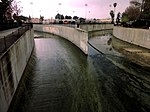Shadow Ranch
1872 establishments in CaliforniaBuildings and structures in the San Fernando ValleyHistory of the San Fernando ValleyHouses completed in 1872Houses in Los Angeles ... and 3 more
Los Angeles Historic-Cultural MonumentsParks in the San Fernando ValleyWest Hills, Los Angeles

Shadow Ranch is a historic ranch house, built from 1869-1872 using adobe and redwood lumber, on the original Workman Ranch in the western San Fernando Valley of Los Angeles, California. For much of the 20th century it was in Canoga Park, but it is now within the boundaries of the West Hills community.
Excerpt from the Wikipedia article Shadow Ranch (License: CC BY-SA 3.0, Authors, Images).Shadow Ranch
Vanowen Street, Los Angeles West Hills Neighborhood Council District
Geographical coordinates (GPS) Address Website External links Nearby Places Show on map
Geographical coordinates (GPS)
| Latitude | Longitude |
|---|---|
| N 34.1945 ° | E -118.6199 ° |
Address
historic ranch house / park office (Workman Ranch House)
Vanowen Street
91307 Los Angeles, West Hills Neighborhood Council District
California, United States
Open on Google Maps






